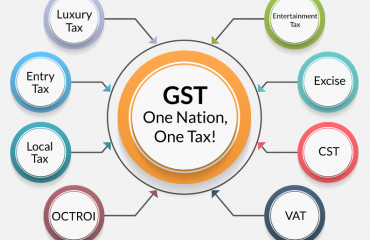
The midnight launch in Parliament five years ago of our tryst with GST, the goods and services tax, was advertised across the country for unifying us into a common market for indirect taxation. Lost in the din of vexation since then over its rickety roll-out and federal friction was GST as a reformist idea for a modern economy drawn from basic economics. For a grasp of why anyone would call it a “good and simple tax", as Prime Minister Narendra Modi did back then, let’s visualize a ‘metaverse’ of sorts, a lab model for taxes as a certainty of life. Anyone keen to set up shop here and earn money would want clarity on success prospects.
The midnight launch in Parliament five years ago of our tryst with GST, the goods and services tax, was advertised across the country for unifying us into a common market for indirect taxation. Lost in the din of vexation since then over its rickety roll-out and federal friction was GST as a reformist idea for a modern economy drawn from basic economics. For a grasp of why anyone would call it a "good and simple tax", as Prime Minister Narendra Modi did back then, let's visualize a 'metaverse' of sorts, a lab model for taxes as a certainty of life. Anyone keen to set up shop here and earn money would want clarity on success prospects. Business-specific risks, while vast and varied, may be considered within the realm of one's control, but what about factors that are not? One such risk would be the currency losing its real value at a rate one cannot predict, which would discredit financial forecasts and stiffen access to credit from lenders who refuse to be ripped off. Another would be the administration's slice of what one charges a customer for stuff; if this doesn't promise to stay stable, its jerky impact could wreak havoc. Hence, for any sphere of commerce to attract entry, instead of taking one's presence for granted, it must offer tax stability. Think digital. With market barriers blurry and goods blending into services, what works across time holds appeal across item divisions too. Taken together, a unified flat levy for everything on sale suggests itself.
In itself, such simplicity is no big deal. For a tax to aid commerce, it should be levied only on value addition. This makes space for one to specialize, which is something that has long been observed to help an economy evolve. In olden days, it made more sense for a woodcutter to supply logs for a rolling pin, someone else to hew its shape out, another worker to polish it and a fourth person to retail it, rather than one pin-maker doing all this. Splitting up work was essential to efficiency. In our internet model, each task that goes into fulfilling some need would be a digital 'gig', with novel specialties in hot demand. If every link in such a value network were to get slapped with a tax from one sale to the next, it would pile up by and by to enlarge the final bill; work best done by experts would happen in-house to conserve cash. But if one could reclaim taxes paid on inputs, with only the part done by one's own gig taxable, then even profit margins squeezed by stiff rivalry would allow specialized success. Overall, a value-added tax (VAT) would spur us to innovate in a quest to gain a special edge.
By definition, any GST is a VAT, but a jumble of rates caught in the flux of real-world pulls and pushes could easily let the basic idea down. What begins as a valid worry about a tax burden on the poor could slip into a kaleidoscope of rate variation. Levy inversions, with inputs charged more than final output, could push costs so high as to defeat one's specialty. If costs along a supply chain were to bloat or shrink without warning, then business would stay nervy. The very expense of complying with the tax could keep an informal unit out of the whole loop, even starve it of contracts from big clients looking for input credits (unless the latter can comply on its behalf). In India's case, we have seen plenty of this happen. While wide disparities do argue against a flat charge for everything on sale, we must never lose sight of the original concept. Let it serve, at the very least, as a guide for GST reforms.
